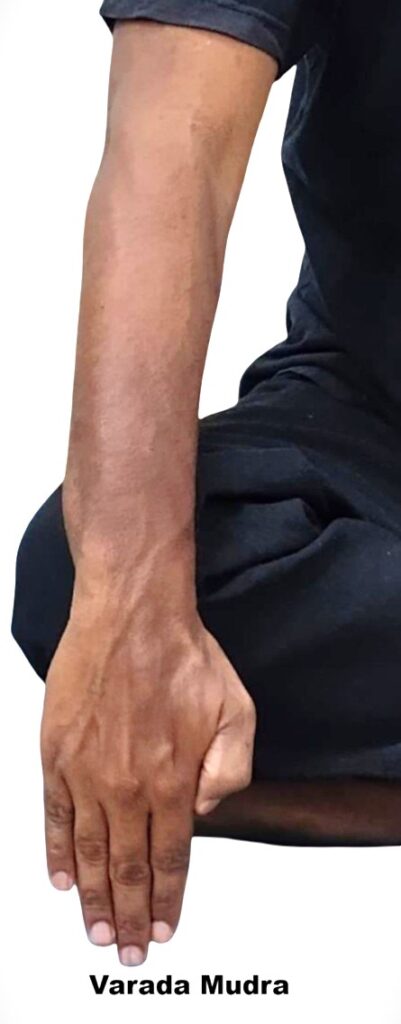Varada Mudra
Introduction
Varada Mudra is a symbolic hand gesture in yoga and classical Indian art that represents charity, compassion, and granting of blessings. It is widely practiced in meditation and spiritual rituals to cultivate generosity, humility, and a sense of giving.
The term Varada comes from Sanskrit:
Vara: Boon, gift, or blessing
Da: Giving
Overall Purpose:
Varada Mudra is used to enhance positive energy, spiritual merit, and mental openness, creating a sense of inner generosity and benevolence.
Meaning
Symbolizes compassion, generosity, and spiritual grace.
Encourages the practitioner to cultivate altruism, kindness, and humility.
Represents the act of granting blessings to oneself and others.
How to Perform / Practice
Sit comfortably in a meditative posture (Padmasana, Sukhasana, or on a chair) with an erect spine.
Come into a sitting position. Practise this mudra with your left hand.
Let your left arm hang down, with the elbow slightly bent, and rest the back of your wrist on your left knee so your hand is in front of the knee with the palm flat and facing outward.
Keep your fingers together and pointing down. Hold for as long as feels comfortable
Practice for 5–15 minutes daily, during meditation or as part of spiritual practice.
Tip: Often combined with Dhyana Mudra of the other hand for balanced energy flow.
Benefits
Physical Benefits:
Relaxes the hand, arm, and shoulder muscles.
Improves circulation in the upper limb.
Supports proper posture while seated in meditation.
Mental & Emotional Benefits:
Cultivates compassion, generosity, and emotional balance.
Reduces stress, selfishness, and negative mental patterns.
Enhances a sense of inner peace and spiritual connection.
Energetic / Spiritual Benefits:
Activates pranic flow in the hands and upper body.
Symbolically opens the heart and energy channels for giving and receiving blessings.
Promotes spiritual growth and connection with higher consciousness.
Contraindications
Avoid if experiencing hand, wrist, or arm injury.
Not recommended for severe arthritis or chronic joint pain.
Discontinue if numbness, tingling, or discomfort occurs.
Practice gently if experiencing shoulder or arm tension.
Anatomy & Physiology
Muscles: Engages forearm and intrinsic hand muscles to maintain the downward extended posture.
Joints: Shoulder abduction and slight elbow flexion; wrist in neutral position.
Nervous System: Activates parasympathetic system, promoting relaxation and emotional calm.
Circulation: Enhances blood flow in the forearm, hand, and fingers.
Kinesiology
Improves static postural stability while seated.
Encourages relaxed arm and hand positioning, reducing muscular tension.
Supports coordinated arm and shoulder alignment.
Neurology
Stimulates brain regions related to empathy, compassion, and emotional regulation.
Balances sympathetic and parasympathetic activity for mental calmness.
Enhances mindfulness and focused attention during meditation.
Duration of Practice
Daily Practice: 5–15 minutes during meditation or spiritual practice.
Short Practice: 1–5 minutes for a quick grounding and emotional balance.
Can be combined with other mudras such as Dhyana Mudra or Chin Mudra for enhanced effect.
Counter Mudra
There is no strict counter mudra, but Dhyana Mudra of the other hand is often paired to balance energy.
Gentle hand shaking or stretching may follow prolonged practice.
Conclusion
Varada Mudra is a gesture of generosity, compassion, and spiritual grace. Regular practice cultivates inner peace, altruism, and emotional balance, making it ideal for meditation, spiritual practice, and self-development. It strengthens both physical posture and energetic flow in the upper body.
FAQ
Q1: Can beginners practice Varada Mudra?
A: Yes, it is safe and easy; start with a few minutes and gradually increase.
Q2: Can it improve emotional well-being?
A: Yes, it enhances compassion, generosity, and reduces negative emotional patterns.
Q3: Can it be combined with other mudras?
A: Yes, often paired with Dhyana Mudra or Chin Mudra for enhanced meditation benefits.
Q4: Is it suitable during meditation?
A: Yes, it promotes emotional calm, spiritual connection, and focused attention.
References
Swami Satyananda Saraswati, Mudras for Healing and Transformation.
Iyengar, B.K.S., Light on Yoga.
Saraswati, S., Pranayama and Mudras in Yoga Therapy.
Fishman, L., Yoga for Emotional Balance.
Journal of Bodywork and Movement Therapies, 2018; 22(4): Effects of Hand Mudras on Mental and Physiological Functions.

